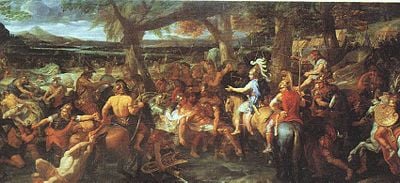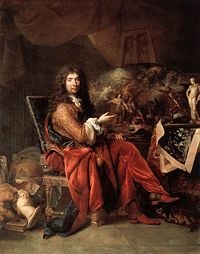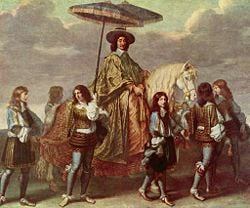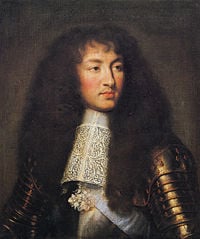Le Brun, Charles
(Applied Category tags, checked spelling, applied Ready tag.) |
David Doose (talk | contribs) (Submitted) |
||
| Line 1: | Line 1: | ||
| − | {{epname|Le Brun, Charles}}{{Contracted}}{{Started}}{{Ready}} | + | {{epname|Le Brun, Charles}}{{Contracted}}{{Started}}{{Ready}}{{Submitted}} |
[[Image:Le brun.jpg|thumb|200px|left|Charles Le Brun, Portrait by Nicolas de Largilliere.]] | [[Image:Le brun.jpg|thumb|200px|left|Charles Le Brun, Portrait by Nicolas de Largilliere.]] | ||
'''Charles Le Brun''' (February 24, 1619 - February 22, 1690) was a true Renaissance man. The reputation he garnered for his paintings was only surpassed by his creations in architecture, both in buildings and in gardens. His place in [[France|French]] history is as notable as his artistic achievements. He was one of the dominant artist and [[Aesthetics|art theorist]]s of France during the [[17th century]]. | '''Charles Le Brun''' (February 24, 1619 - February 22, 1690) was a true Renaissance man. The reputation he garnered for his paintings was only surpassed by his creations in architecture, both in buildings and in gardens. His place in [[France|French]] history is as notable as his artistic achievements. He was one of the dominant artist and [[Aesthetics|art theorist]]s of France during the [[17th century]]. | ||
Revision as of 09:56, 20 December 2007
Charles Le Brun (February 24, 1619 - February 22, 1690) was a true Renaissance man. The reputation he garnered for his paintings was only surpassed by his creations in architecture, both in buildings and in gardens. His place in French history is as notable as his artistic achievements. He was one of the dominant artist and art theorists of France during the 17th century.
Le Brun was well liked, well respected, and thus well employed by several political figures in France. These included Chancellor Pierre Séguier, Cardinal Richelieu and Nicolas Fouquet. Under their directions, Le Brun was given leave to create some of the most impressive masterpieces seen in the history of France. He particularly is recognized for his brilliant and captivating religious paintings.
However, many critics proclaim his crowning achievement the Palace of Versailles. Le Brun designed every detail of perfection of Versailles, including the architecture, decorations, and landscape. The King, Louis XIV and his chief minister Jean-Baptiste Colbert commissioned Le Brun for the endeavor, and they were not disappointed.
Charles Le Brun dominated his time like no other artist. It was hard to find his equal in France, he was esteemed as the most talented artist of his day. Many critics say that it was not until the appearance of Jacques-Louis David, that artistic authority was again so concentrated in one man.
Early Life
Charles Le Brun was born into art. His father, a Parisian sculpture, believed that art and education were both important. So, at the young age of eleven, Le Brun was placed in the studio of Simon Vouet. This placement was the direct result of attention paid Le Brun by Chancellor Séguier. He also studied under the direction of François Perrier.
Four years later, Le Brun began receiving commissions for his work. At the young age of fifteen, Le Brun began painting for the very influential and famed people in France, Cardinal Richelieu. The Cardinal was so impressed by Le Brun's talent and ability that he received praise and laud not just from Richelieu, but other esteemed artist as well. One among them was Nicolas Poussin. In 1642, Poussin and Le Brun ventured to Rome for more in depth practice with their art.
Le Brun remained in Rome for just over four years, working under Poussin. He was able to afford his lodgings and livings because of a pension he received from the chancellor, who had not forgotten the talent he helped to foster in young Le Brun. It was under this close tutelage that Le Brun was taught, influenced, and eventually adapted Poussin's art theories.
In 1646, Le Brun recognized that it was time to return home to Paris and begin his career as a painter. His education was finished, and now he would begin making a living at doing what he loved most. Once back in Paris, the work came quickly and easily. Among Le Brun's esteemed patrons was a man considered very important: Superintendent Fouquet. For Fouquet, Le Brun painted a very grand portraits of Anne of Austria. The painting was large, beautiful, and helped to further Le Brun's already pristine reputation.
Le Brun went on to find employment at the chateau of Vaux-le-Vicomte, just south of Paris. It was during this time that Le Brun gained the good graces of Cardinal Mazarin, Richlieu's predecessor. Le Brun also used strategy to gain the attention of Jean-Baptiste Colbert, the minister of finance to Louis XIV. Colbert saw in Le Brun the organization with which Le Brun executed his life and and Le Brun attached themselves as business partners. The two eventually took control of the Academy of Painting and Sculpture (Académie royale de peinture et de sculpture, 1648), and the Academy of France at Rome (1666), and gave a new development to the industrial arts.
Dominant artist
Continuing their working relationship, Le Brun and Colbert established Gobelins manufactory. This began as a school for the basic manufacture of various furniture to be used in the royal palaces, not for the tapestries it would become known for. Le Brun was now commanding and serving as director for the industrial arts at Gobelins. Simultaneously, he held posts with the Academy. Through these two facets, Le Brun basically had some sort of say on every piece of art that was being produced in France during his lifetime. Not only this, but his contributions were great as well. He became known as the inventor of the Louis XIV Style and also gave a direction to the national tendencies which endured centuries after his death.
Charles Le Brun found favor with King Louis. The king of France was known for his pompous and decadent tastes, and he found that many of Le Brun's paintings captured the characteristics he most wanted to emphasize. He admired the decorations at Vaux-le-Vicomte so much that he soon began commissioning Le Brun for other work. One of the commissions was for a series of subjects from the history of Alexander. The very first in the series was titled, "Alexander and the Family of Darius." This painting was an immediate success with the king that he bestowed a title on Le Brun, making him part of the nobility. With Le Brun's successive paintings, including Le Premier Peintre du Roi (The First Painter of his Majesty), the admiration of the King, and therefore of France grew to the point where Louis declared him "the greatest French artist of all time." For his work for the king, Le Brun received a pension of 12,000 livres.
From these successes, the approval of the king, and the magnificent talent that was illustrated in the work Le Brun was doing, he became the director of all that was done in the royal palaces. The following year, he became director of the Académie royale de peinture et de sculpture, where he laid the basis of academicism and became the all-powerful, peerless master of seventeenth century French art. With all of this, Le Brun began a new series of paintings dealing with the history of Alexander the Great. The paintings, The Battles of Alexander The Great opened up another way for Le Brun to flatter the king. He continually made comparisons between the two leaders, much to the satisfaction of Louis XIV. It was during these paintings that Le Brun's characteristic style emerged. He came more fully into his individual style as he moved away from the ancient masters who had influenced him.

The next few years found Le Brun working steadily. He began his works that make up the gallery of Apollo , now housed in the the Louvre, although he never finished them. Le Brun stopped this series of paintings to travel with the king to Flanders, upon return he took up residence in the the small Château de Saint-Germain-en-Laye), where he completed several small compositions. But by far, his largest and most time consuming project was reserved for his efforts at the palace of Versailles. Le Brun dictated how much of Versailles should be created and kept, but he also reserved special projects, such as the Halls of War and Peace (Salons de la Guerreand de la Paix, 1686), the Ambassadors' Staircase, and the Great Hall of Mirrors (Galerie des Glaces, 1679–1684 for himself. Le Brun's decoration is not only a work of art, it is the definitive monument of a king's reign and a reflection of the history of France.
At the death of his partner, Colbert, François-Michel le Tellier, Marquis de Louvois, Colbert's enemy, was named the successor as superintendent in the department of public works. With this change in leadership, Le Brun experienced something he wasn't used to, Louvois did not care for him. Even with the support of the king, Le Brun felt a definite change in his position, and he no longer enjoyed the freedom he had had while Colbert was alive. These changes contributed to Le Brun's illness, which ended in death on February 22, 1690 in his private mansion, in Paris.
Legacy
With all of Le Brun's contributions to the world of 17th century French art, there have been many critics. Some claim that for Le Brun to be the person he was and to accomplish the things that he did, he must have been a tyrannic despot. Some say that was absolutely not true and that Le Brun was an artistic genius. What can be known is the facts. Before Le Brun died, he was re-elected as director by the Academy, despite the threats of Louvois. Even after Le Brun died, the Academy continued to honor him, no director before or since has received so much attention.
Le Brun primarily worked for King Louis XIV, for whom he executed large altarpieces and battle pieces. His most important paintings are at Versailles. Besides his gigantic labors at Versailles and the Louvre, the number of his works for religious corporations and private patrons is enormous. Adding to these accomplishments, Le Brun was also a fine portraitist and an excellent draughtsman, although he was not fond of performing such tasks. What had always mattered to Le Brun was the scholarly composition, whose ultimate goal was to nourish the spirit. His ultimate desire was to make his paintings speak, through a series of symbols, costumes and gestures that allowed him subtly add to his composition the narrative elements that gave his works a particular depth. For Le Brun, a painting represented a story one could read. Nearly all his compositions have been reproduced by celebrated engravers.
After Charles Le Brun died, his treatise Méthode pour apprendre à dessiner les passions (1668) was published. In the treatise Le Brun reemphasized the expression of emotion that was evoked during the painting process. He wrote about these emotions in beauty and detail, and the results of his writings were studied in art theory classes over the next two centuries.
Many of his drawings are in the Louvre and the Monaco Royal Collection.
ReferencesISBN links support NWE through referral fees
- Morel d'Arleux, Louis-Marie-Joseph. 1827. Dissertation sur un traité de Charles Le Brun concernant le rapport de la physionomie humaine avec celle des animaux.
- Pinault-Sorensen, Madeleine. 2000. De la Physionomie Humaine et Animale: Dessins de Charles Le Brun gravés pour la Chalcographie du Musée Napoleon en 1806. Paris, FR: Musée du Louvre. ISBN 2-7118-4094-8.
External links
- Charles Le Brun Charleslebrun.com. Retrieved December 20, 2007.
- Charles LeBrun Ibiblio.org. Retrieved December 20, 2007.
- Charles Lebrun Newadvent.org. Retrieved December 20, 2007.
- Charles Le Brun Artcyclopedia.com. Retrieved December 20, 2007.
- Colantuono, Anthony. 1996. The Expression of the Passions: The Origin and Influence of Charles le Brun's "Conference sur l'expression generale et particuliere.' Findarticles.com. (Art Bulletin) Retrieved December 20, 2007.
- Tapestries Oldandsold.com. Retrieved December 20, 2007.
Warning: Default sort key "Brun, Charles Le" overrides earlier default sort key "Le Brun, Charles".
Credits
New World Encyclopedia writers and editors rewrote and completed the Wikipedia article in accordance with New World Encyclopedia standards. This article abides by terms of the Creative Commons CC-by-sa 3.0 License (CC-by-sa), which may be used and disseminated with proper attribution. Credit is due under the terms of this license that can reference both the New World Encyclopedia contributors and the selfless volunteer contributors of the Wikimedia Foundation. To cite this article click here for a list of acceptable citing formats.The history of earlier contributions by wikipedians is accessible to researchers here:
The history of this article since it was imported to New World Encyclopedia:
Note: Some restrictions may apply to use of individual images which are separately licensed.


